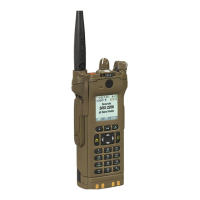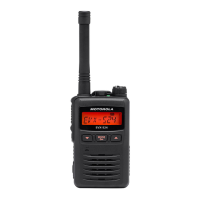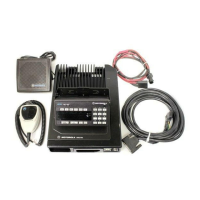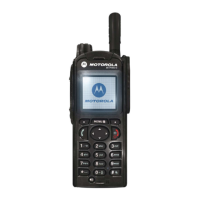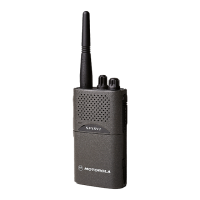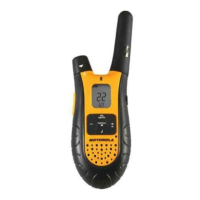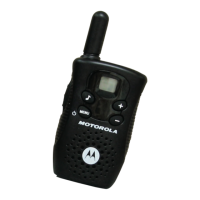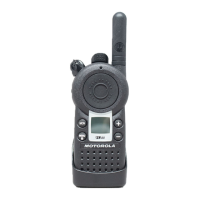
Do you have a question about the Motorola SRX 2200 and is the answer not in the manual?
| Water Resistance | IP67 |
|---|---|
| Emergency Button | Yes |
| Bluetooth | Yes |
| GPS | Yes |
| Frequency Range | 136-174 MHz |
| Channel Capacity | 1000 |
| Display | Monochrome |
| Encryption | AES, DES |
| Power | 1-5 watts |
| Battery | Li-Ion |
| Operating Temperature | -30°C to +60°C (-22°F to +140°F) |
Details Motorola's intellectual property, trademarks, and usage licenses.
Covers open source software, disposal regs, and feature variability notes.
Lists features supported by software version R31.00.00 or later.
Explains manual notations and provides basic radio care.
Info on battery disposal and consulting dealer/admin.
Steps to attach battery, antenna, and accessory cover.
Procedures for clips, holders, and radio power/volume.
Identifies physical parts and controls of the radio.
Explains customizable button functions and features.
Details Bluetooth settings and basic call setup functions.
Covers emergency modes, scan, and security features.
Manages keypad lock, display backlight, and NVG setup.
Covers TX power, voice announcement, and voice mute.
Explains battery level indicators via icons and LEDs.
Describes the meaning of solid, blinking, and rapid blinking LED lights.
Alerts to mismatches between radio and battery HAZLOC certification.
Explains icons for receiving, transmitting, calls, and battery status.
Explains icons for direct mode, monitoring, power, and scan status.
Details icons for zone banks, secure operations, and GPS.
How display backlight and color signal radio events.
Lists alert tones and the conditions that trigger them.
Uses display color changes for visual channel identification.
How to select zones and channels using switches/knobs.
Explains how to receive and respond to talkgroup calls.
Procedures for private and telephone calls in trunking mode.
Ways to select zones, channels, or talkgroups for calls.
Steps for making talkgroup, private, and enhanced private calls.
How to switch between talkaround and repeater operation.
How to use the monitor feature to check channel clarity.
Steps to monitor channels and conventional mode.
Enhancements for data, system resilience, and crosstalk.
Features for secure comms, key management, and repeater systems.
Improves scan feature for multiple agencies on one frequency.
Explains various call features available on the radio.
Allows private calls from specific individuals.
Procedures for priority dispatch and dynamic regrouping.
Notifying dispatcher and modifying PL/DPL codes.
Remotely monitoring radios and managing scan lists.
Managing priority scan lists and channel status.
Controls for scan function and dynamic priority changes.
Procedures for deleting and restoring nuisance channels.
Explains how to receive and send call alert pages.
Accessing recent calls and saving/playback of received calls.
Mutes affiliated talkgroups while allowing alert tones for specific calls.
Explains modes for indicating critical situations and emergency signals.
Scenarios during emergency ops and how to exit.
How supervisors exit emergency and remote emergency features.
Procedures for sending emergency alarms and calls.
Emergency calls with hot mic and combined alarm/call features.
Combined alarm/call with hot mic and silent alarm procedures.
Feature for locating radios in emergency and fall detection.
Explains Fall Alert triggers, alerts, and testing procedures.
Procedure for enabling secure transmission modes.
Procedure for enabling clear transmission modes.
Steps to load keys and explanation of multikey feature.
Procedures for key erasure and rekey requests.
MDC OTAR features and infinite UKEK retention.
Noise reduction system and feature to disable radios.
GNSS/GPS integration and selection of location display formats.
How the location feature behaves during emergency mode.
Actions and notifications when entering a geofence area.
Ensures communication during trunked system failure.
Radio status when out-of-range and SmartConnect functionality.
Site reverts to trunking and site lock/unlock procedures.
Procedures for viewing and changing the current radio site.
Steps to pair radio with accessories using LF-MPP.
Holster, weapon fired, and vest pierced sensor events.
Specifics on holster and weapon fired sensor functionality.
Vest pierced sensor and procedures to disable sensors.
How to accept or reject configuration/firmware upgrades.
Audibly indicates feature mode, zone, or channel assigned.
Lighting indicator with audio alert for special situations.
Steps to connect radio to Wi-Fi networks.
Procedures to manage Wi-Fi and check its status.
Managing zone banks, power levels, and display backlight.
Setup for NVG, keypad locking, and voice mute functions.
Using time-out timer and conventional squelch operation.
Using PL defeat, PTT ID, and Smart PTT functions.
Procedures for controlling radio transmission inhibition.
Information on FCC certified accessories and compatibility.
General disclaimers, FCC conformity, and operating conditions.
RF exposure safety guidelines and FCC/ISED user notices.
Procedures for obtaining FCC and Canadian radio licenses.
Emergency/non-commercial channels and FCC frequency rules.
Table listing VHF marine channels and their frequencies.
Compliance for distress frequencies and external data interfaces.
Details what the warranty covers, its duration, and general terms.
Warranty terms, state rights, and how to get service.
Lists warranty exclusions and patent/software terms.
Specifies governing law and Australian consumer law.
Alphabetical listing of terms and definitions from ACK to Central Controller.
Alphabetical listing of terms and definitions from Channel to FCC.
Alphabetical listing of terms and definitions from Hang up to MDC.
Alphabetical listing of terms and definitions from Non-tactical/revert to Squelch.
Alphabetical listing of terms and definitions from SSI to Zone.
